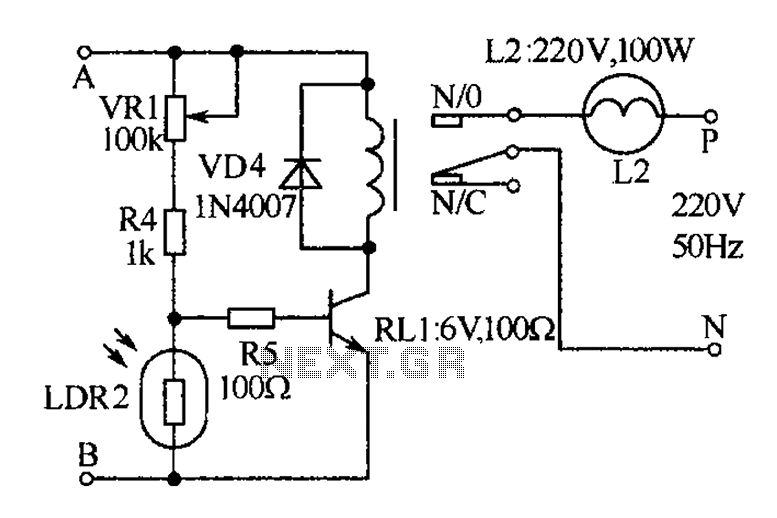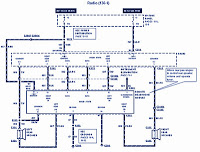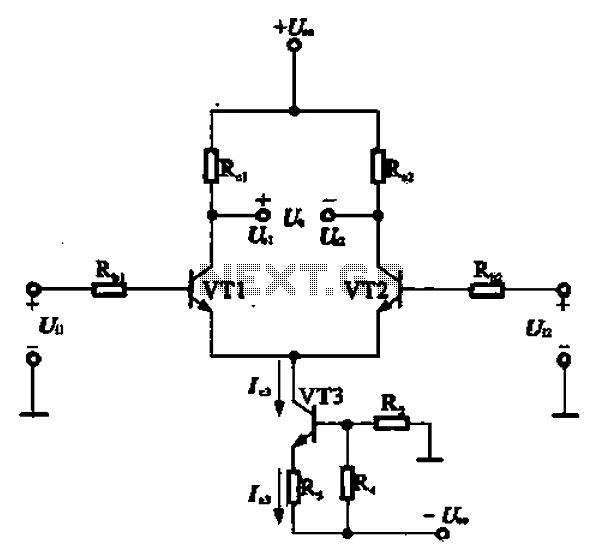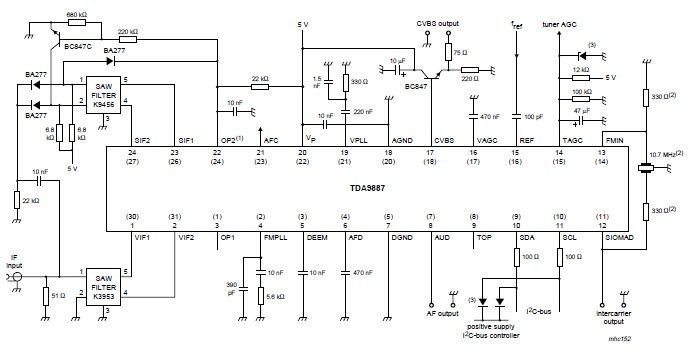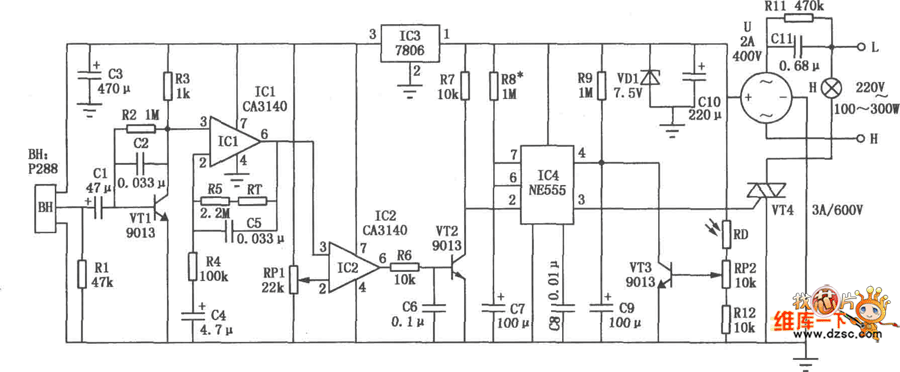
The Metal Detector Circuit

This design has not been referred to as a GOLD detector, as that term is reserved for more complex devices capable of distinguishing gold from other metals. There is a significant difference between detecting gold and ordinary metals, known as base metals. The operation of the detector is based on an oscillator, which maintains oscillation through positive feedback. This is characteristic of all oscillators, with the feedback provided by a 1n capacitor connected between the collector and emitter of the transistor. Although it may seem unconventional for the transistor to be activated via the emitter to sustain oscillation, the critical factor is the voltage difference between the emitter and base terminals. If the base voltage is held constant while the emitter voltage decreases, the transistor experiences a greater voltage difference between these terminals, resulting in a stronger ON state. Conversely, if the emitter voltage increases, the transistor turns OFF as the voltage difference diminishes. This behavior is integral to the circuit's operation. The 1n capacitor between the collector and emitter modulates the voltage at the emitter, facilitating the transistor's switching. This is achieved by continuously monitoring the voltage across the tuned circuit and transmitting changes to the emitter. In this project, the TUNED CIRCUIT consists of parallel components, including the inductor (the search coil) and the 1n capacitor connected across it. This configuration forms an LC circuit, where L represents the inductance of the inductor in Henries (or mH or µH) and C denotes the capacitance of the capacitor in Farads (or µF, nF, or pF). The process begins when the transistor turns ON, allowing a pulse of energy to flow into the tuned circuit. This pulse of energy (current) initially attempts to enter both the coil and capacitor. Although the coil typically has lower resistance, the capacitor, being uncharged, presents an effective zero resistance and begins to charge. As a small voltage develops across the capacitor, the coil eventually becomes the path of least resistance due to its few turns of copper wire.
The described circuit operates as a basic oscillator, utilizing a transistor in conjunction with an LC circuit to generate oscillations at a specific frequency. The inductor, functioning as the search coil, is responsible for detecting metal objects by generating a magnetic field. When a metal object, such as gold, enters this field, it alters the inductance, which in turn affects the oscillation frequency of the circuit. The feedback loop formed by the 1n capacitor is crucial for maintaining the oscillation, as it allows the circuit to self-regulate and react to changes in the environment.
The design's simplicity is an advantage, as it provides a cost-effective solution for basic metal detection applications. However, it is important to note that this circuit does not possess the capability to discriminate between different metals. For users seeking to identify gold specifically, more advanced circuitry and signal processing techniques would be necessary. These could involve the use of additional components such as operational amplifiers, microcontrollers, or specialized algorithms for frequency analysis.
In summary, while this circuit serves as a foundational oscillator for metal detection, its limitations must be acknowledged. The interplay between the inductor, capacitor, and transistor creates a dynamic system that responds to external stimuli, but it lacks the sophistication required for precise metal discrimination.This design has not been called a GOLD detector as this name has been left for the more complex detectors that actually discriminate been gold and other metals. There is an enormous difference between detecting gold and ordinary metals (called base metals). How the detector work The circuit is an oscillator and the way it keeps oscillating is due to positive feedback. This is the case with all oscillators and the component that provides the feedback is the 1n capacitor between the collector and emitter of the transistor. It may seem unusual that the transistor can be turned on via the emitter to keep it oscillating, but in fact it does not matter if the emitter or base receives a signal as the important factor is THE VOLTAGE DIFFERENCE between these two terminals.
If the base is kept fixed and the emitter voltage is reduced, the transistor sees a higher voltage between the base and emitter and it is turned ON harder. If the voltage on the emitter increases, the transistor turns OFF as the difference between the two is reduced.
This is exactly what happens in this circuit. The 1n capacitor between the collector and emitter influences the voltage on the emitter to turn the transistor on and off. It does this by constantly monitoring the voltage on the tuned circuit and passing the change to the emitter.
In this project, the TUNED CIRCUIT is the parallel components consisting of the inductor (the search coil) and the 1n capacitor across it. This is called an LC circuit in which the L is the inductance of the inductor in Henries (or mH or uH) and C is the capacitance of the capacitor in Farads (or uF or nF or pF).
We start when the transistor turns ON and allows a pulse of energy to enter the tuned circuit (later you will see how the transistor turns on). The pulse of energy (current) starts by trying to entering both the coil and capacitor. You would think the coil has the smallest resistance but the capacitor is uncharged and presents a theoretical zero resistance and begins to charge.
When a small voltage appears across it, you would think the coil would become the least resistance as it consists of only a few turns of copper wire. 🔗 External reference
The described circuit operates as a basic oscillator, utilizing a transistor in conjunction with an LC circuit to generate oscillations at a specific frequency. The inductor, functioning as the search coil, is responsible for detecting metal objects by generating a magnetic field. When a metal object, such as gold, enters this field, it alters the inductance, which in turn affects the oscillation frequency of the circuit. The feedback loop formed by the 1n capacitor is crucial for maintaining the oscillation, as it allows the circuit to self-regulate and react to changes in the environment.
The design's simplicity is an advantage, as it provides a cost-effective solution for basic metal detection applications. However, it is important to note that this circuit does not possess the capability to discriminate between different metals. For users seeking to identify gold specifically, more advanced circuitry and signal processing techniques would be necessary. These could involve the use of additional components such as operational amplifiers, microcontrollers, or specialized algorithms for frequency analysis.
In summary, while this circuit serves as a foundational oscillator for metal detection, its limitations must be acknowledged. The interplay between the inductor, capacitor, and transistor creates a dynamic system that responds to external stimuli, but it lacks the sophistication required for precise metal discrimination.This design has not been called a GOLD detector as this name has been left for the more complex detectors that actually discriminate been gold and other metals. There is an enormous difference between detecting gold and ordinary metals (called base metals). How the detector work The circuit is an oscillator and the way it keeps oscillating is due to positive feedback. This is the case with all oscillators and the component that provides the feedback is the 1n capacitor between the collector and emitter of the transistor. It may seem unusual that the transistor can be turned on via the emitter to keep it oscillating, but in fact it does not matter if the emitter or base receives a signal as the important factor is THE VOLTAGE DIFFERENCE between these two terminals.
If the base is kept fixed and the emitter voltage is reduced, the transistor sees a higher voltage between the base and emitter and it is turned ON harder. If the voltage on the emitter increases, the transistor turns OFF as the difference between the two is reduced.
This is exactly what happens in this circuit. The 1n capacitor between the collector and emitter influences the voltage on the emitter to turn the transistor on and off. It does this by constantly monitoring the voltage on the tuned circuit and passing the change to the emitter.
In this project, the TUNED CIRCUIT is the parallel components consisting of the inductor (the search coil) and the 1n capacitor across it. This is called an LC circuit in which the L is the inductance of the inductor in Henries (or mH or uH) and C is the capacitance of the capacitor in Farads (or uF or nF or pF).
We start when the transistor turns ON and allows a pulse of energy to enter the tuned circuit (later you will see how the transistor turns on). The pulse of energy (current) starts by trying to entering both the coil and capacitor. You would think the coil has the smallest resistance but the capacitor is uncharged and presents a theoretical zero resistance and begins to charge.
When a small voltage appears across it, you would think the coil would become the least resistance as it consists of only a few turns of copper wire. 🔗 External reference
